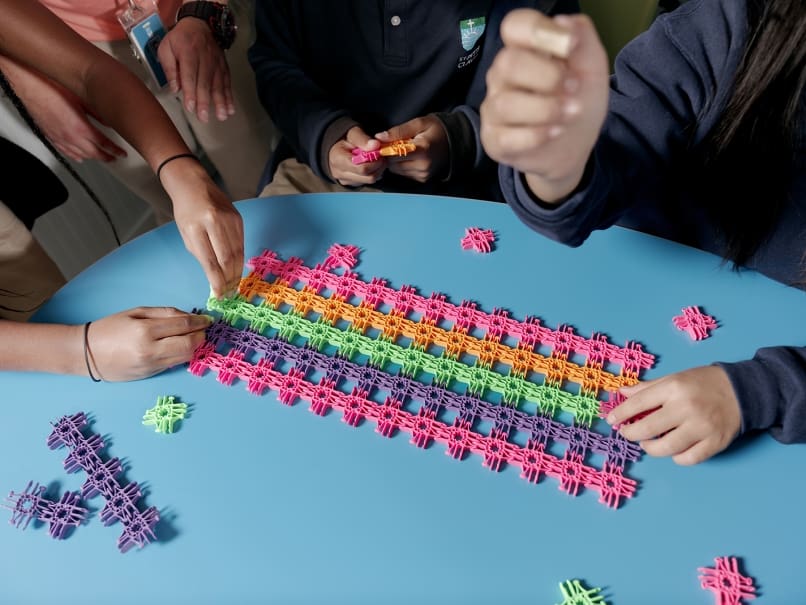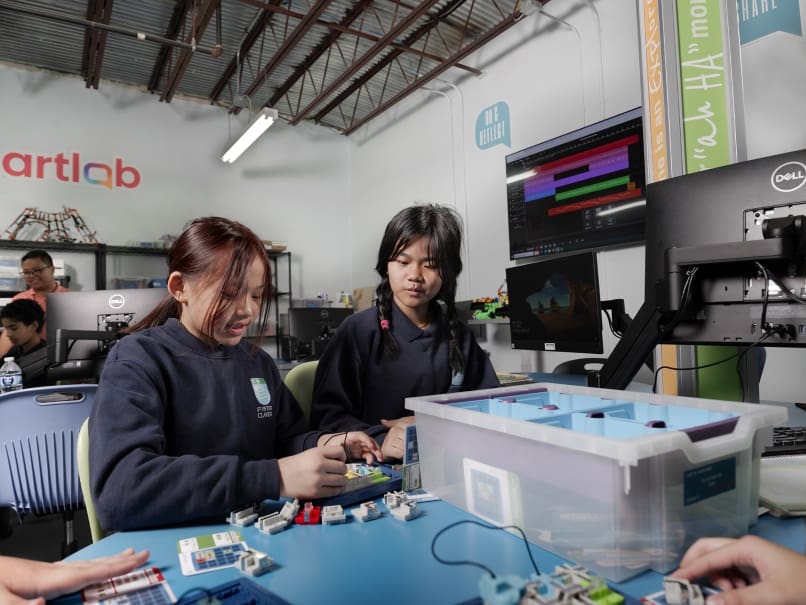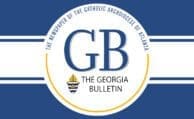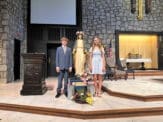Smartlab Facilitator Phu Vu teaches a fifth-grade class how to operate one of their robots at St. Peter Claver Regional School. The new lab space helps introduce students to a different set of skills. Photo by Johnathon Kelso
Rome
Schools bring STREAM labs, technology to spark young minds
By ANDREW NELSON, Staff Writer | Published March 30, 2023
ROME—In Megan Hunsaker’s lab, follow your curiosity.
Hunsaker is the facilitator for the state-of-the-art lab at St. Mary’s School in Rome, which brings together computer coding, communications, engineering and so much more.
The new facility’s aim is “learning the 21st-century skills,” which weaves all the academics together, the veteran teacher said.
Schools in the archdiocese are showcasing innovative ways to teach science and engineering. Educators said students may not become doctors or scientists, but they will learn life skills.
The Rome school recently celebrated the opening of its new STREAM lab. Using hands-on activities, this lab enlivens teaching science, technology, religion, engineering, the arts and math. In the gymnasium of St. Mary’s Academy in Fayetteville, an autonomous robot joins the dance team’s routines, but also prepares high schoolers with cutting edge artificial intelligence and machine learning. At Decatur’s St. Peter Claver Regional School, a dusty, underutilized storage room got a makeover to turn it into a hub of learning.
The St. Mary School lab is well equipped, with 12 desktop computers, loaded with programs for computer coding, animation and 3D printing. There is space for “pad casting” with a green screen and a video camera. Students have access to boxes of resources to create sustainable science projects, creating solar and wind power projects, along with engineering kits for robotics and drones.
“This is like a whole new world,” Hunsaker said.
The lab cost $280,270 paid with a grant from the Archdiocese of Atlanta school support budget. Each of the school’s nearly 200 students will spend time in the lab, with middle schoolers getting two weekly visits.
Hunsaker is a veteran art teacher. Her work in this space is largely to encourage student-directed work and to be reflective. For her, the process in the lab unfolds in the same way she teaches art, first exposing students to the new materials, exploring its capabilities together and then letting students discover on their own.
She said much of her time is spent walking around, asking questions and curious prompts to get students to be creative and problem solve. She is one of three staff trained for the lab.
As a Catholic school, it is important to link faith and the sciences will all the subjects. Hunsaker said her goal with students is “teaching wisdom with technology,” raising questions with the kids about ethical uses of technology. She also links what happens in the lab and the biblical understanding of how women and men are driven to be creators, mirroring God’s handiwork.
“We were created to be makers” she said.
St. Peter Claver opened a lab in the fall
Instructor Phu Vu leads the fifth graders into gym at St. Peter Claver Regional School. Everyone guided the rolling robot, with loud laughter from the students as it locked on to a classmate’s face and followed her like a pet.
Later, back in the lab, the students split into project groups. Some were designing menus for their own restaurants with a graphic design program. Others were building a house. One group pulled out a bin of circuitry tools.
Angela Mkhumdui, 10, took an “expert” level challenge card to master circuitry. Using a combination of colored blocks, she built a circuit that would turn on a lightbulb.
She likes the lab program, especially how it makes the students work in teams to figure out problems and discuss. Mkhumdui also likes how the students have access to software that helped her create a seven-slide presentation about Greek mythology.
John Bosco Khai Deihsum, 11, said his most successful project was constructing a path for a robot to follow. He said the class gives him a chance to build and fix fun things.
A $308,000 federal grant during the COVID emergency helped convert a storage room into a lab. The grant was awarded to nonpublic schools that enroll a significant percentage of low-income students.
School leaders teamed with Creative Learning Systems in the summer of 2022 to create this learning space. A line from the book of Ecclesiastes hangs on the wall: “I apply my mind to search and investigate in wisdom all things that are done under the sun.” (Eccl 2:13)
Sitting in groups of six, the students use technology to learn together and solve problems, then share presentations highlighting their steps.
The school lesson plans are guided by the curriculum standards. Principal Susanne Greenwood said the plans draw students together into the learning as partners.
“The engagement is there because they need each other to achieve their project,” she said.
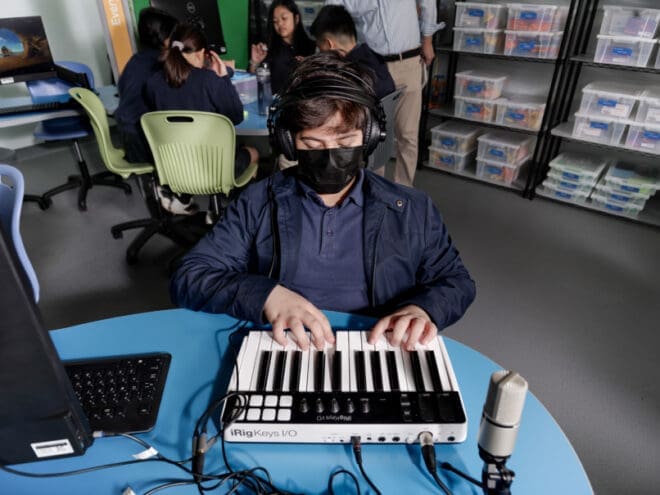
Fifth-grade student Martin Neri works inside a new Smartlab at St. Peter Claver Regional School in Decatur. A federal grant helped convert a storage room into a lab. Photo by Johnathon Kelso
Vu said his goal is for students to learn applicable skills they will take to middle school, high school and beyond.
“That’s all hands-on experience,” he said.
Any teacher hears students ask how what’s learned in a classroom applies to life, said Greenwood, and this lab answers those questions. They see what they learn become something they can hold and manipulate, Greenwood said.
Working in this setting gives students exposure to skills that’ll be required in high school and beyond. In addition to connecting with the school’s math and science lesson plans, students get experience in setting goals, overcoming hurdles to achieve the projects and working side by side with peers, she said.
Robotics initiative prompts new ideas
Roaming the halls at St. Mary’s Academy in Fayetteville is a robot dog, nicknamed “Sonny the Robot Bobcat,” since the school’s mascot is a bobcat. It’s just one part of an introduction of robotics at the school. Some 80 students participated in its first year as an afterschool club.
Brent Hollars, the school’s director of IT and STEM electives, said students have embraced this initiative. He said students are excited to test concepts that will drive advanced technology going forward, like artificial intelligence.
Even the smallest students get to discover new ideas with this curriculum. High schoolers work alongside the younger students, in addition to getting the chance to step up as leaders on their own projects, he said.
“Sonny” makes appearances at the events inside and outside the school. Few schools could involve students in this high-level work, he said. Students start with simple commands to move the robot’s legs then take on advanced commands to engage its sensors and cameras to make it to identify faces.
Hollars expects more students will become hooked to explore this field at the school. They will see how this computer work is expected to be the next advancement in technology, as well as an economic driver for high paying jobs if they pursue it as a career option, he said.


